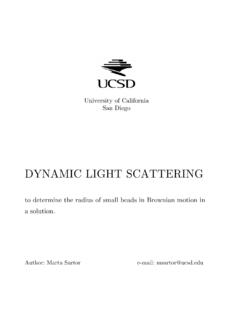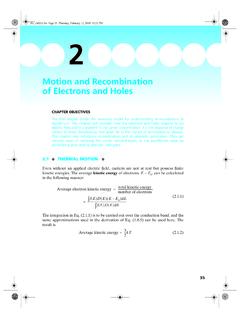Transcription of Fiber Laser Chirped Pulse Amplifier - Calmar
1 Fiber Laser Chirped Pulse Amplifier White Paper PN 200-0800-00. Revision June 2013. Calmar Laser , Inc Overview Fiber lasers offer advantages in maintaining stable operation over years, low total cost of ownership, and predictable operation in a small package. See our white paper Fiber Laser Advantages . Ultrashort pulses are a new technology with many applications from sampling to non-thermal machining and surgery. Fiber lasers provide a stable and reliable mode-locked platform for generation of these pulses. These ultrashort Pulse Fiber lasers are the primary expertise of Calmar Laser . Rather than higher average power, higher energy pulses are sometimes required for applications such as non-thermal machining or surgery. However, the small optical mode diameter in a Fiber limits short Pulse energy throughput due to nonlinear optical mechanisms.
2 Although Fiber lasers can generate Kilowatts of average Laser power, sub-picosecond Pulse energies are limited to 10s of J in commercial systems today. The Fiber Laser Chirped Pulse Amplifier (FLCPA) is one method for increasing the energy output of a Fiber to many J and above. The Chirped Pulse Amplifier is a method for amplifying short pulses by time stretching in such a way that the stretched Pulse can later be recompressed back into a short Pulse after the Fiber Amplifier system. The typical method for stretching is to chirp the short Pulse , where different optical frequencies are delayed by different amounts of time to create a much longer Pulse . The chirp stretching can be accomplished with a grating pair or a Fiber grating. The typical method for recompressing a Chirped Pulse is a grating pair in free space at the exit aperture of the Laser .
3 This grating pair is the only free-space element of the FLCPA, which typically emits a beam in free space that's guided to the target by free-space optics that can handle the high peak energy. Although FLCPA have been demonstrated to generate 100s of J of optical Pulse energy in scientific experiments, current commercial FLCPAs are in the 10 J range. With a Pulse rate of 100s of KHz, overall FLCPA produce an average power of several Watts of high energy sub- picosecond pulses. The Seed Laser The Chirped Pulse Amplifier must be seeded by a high quality femtosecond source Pulse . Calmar Laser 's femtosecond Laser sources are passively mode-locked Fiber lasers (FPL - femtosecond pulsed Laser ). Passive mode-locking makes these lasers easier to operate than actively mode- locked lasers, as no external RF clock signal is required, and little or no warm-up time is needed.
4 Temperature control is also less of an issue with passive mode-locked lasers. Calmar Laser 's passively-mode-locked lasers produce pulses as short as 80 fs. Repetition rates are fixed in the range of 10 - 100 MHz. The peak output power of a femtosecond Laser is, of course, high due to the short Pulse durations, and peak powers up to 10 KW can be achieved using an integrated Fiber Amplifier . Figure 1 shows a simplified schematic of a passively mode- locked Fiber Laser . 200-0800-00 Fiber Laser Chirped Pulse Amplifier 2. Figure 1 Schematic of Passive Mode-locked Fiber Laser Since Calmar 's Fiber lasers are manufactured from discrete components, dispersive and non- linear effects can be carefully controlled. Pulse shape is transform-limited, and the pedestal is typically 20dB lower than the signal.
5 Fiber lasers can make some of the highest quality short seed pulses at low energy. Wavelength can be tuned from 1535 nm to 1560nm (C-band) or from 1030 to 1065 nm (1 m). with a simple adjustment from the front panel of the Laser or fixed internally at one wavelength. The capability to phase-lock the repetition rate to an external clock is available as an optional upgrade. In this scenario, a low jitter phase lock loop precisely tracks the Laser repetition rate to an external clock. This feature is particularly useful for optical sampling applications. Calmar 's lasers are recognized for their stability, as demonstrated by their low timing jitter and low amplitude noise, thereby ensuring that the quality of the Laser output meets even the most stringent test requirements.
6 200-0800-00 Fiber Laser Chirped Pulse Amplifier 3. The Chirped Pulse Amplifier The high quality seed Laser Pulse is sent through an optical Fiber Amplifier system as shown in Figure 2. Figure 2 Fiber Laser Chirped Pulse Amplifier Diagram But high-energy short- Pulse light propagating in a small diameter Fiber creates numerous nonlinear problems. First is the generation of self phase modulation. The light power itself will change the index of refraction in which it propagates. It causes, in many cases, undesirable effects such as optical spectral broadening and ill defined frequency chirp that prevents efficient Pulse compression. A second problem is stimulated Raman scattering, or the creation of new light at shifted wavelengths via molecular vibration states in the glass Fiber itself.
7 Once triggered, it depletes the power in desired signal wavelengths, often limiting ultimate obtainable energy from the Fiber system. These nonlinear effects can distort Pulse shapes and modify the optical spectrum. Although the effects are usually detrimental, they can sometimes be useful in different manipulation, such as a Soliton wave, or for expanding the gain spectrum to get a shorter Pulse . Ultrafast Fiber lasers are dominated by nonlinear optical effects, which is rare in the free-space optical world. Fortunately, Calmar knows how to deal with the effects and with proper engineering can use nonlinear optical effects to advantage in Laser systems. As the peak power of the light increases, the nonlinear effects become stronger. Several methods are used to lower the peak intensity effects, to allow more Pulse energy to be handled.
8 First, the short Pulse is spread out in time by frequency, or Chirped . A typical method uses a diffraction grating pair, although Fiber counterparts exist. After the Pulse has traveled through the Fiber optical system, the Pulse can be recompressed back to an ultra-short Pulse . This recompression may need to be done in free space if the peak Pulse intensity is too high to allow further propagation in a Fiber . Second, a larger diameter Fiber core can be used. Recently, large mode aperture fibers have been developed that can increase the Fiber area by an order of magnitude or more, while remaining single mode. Finally, new photonic band gap (PBG) fibers use an air core with much less nonlinear effects. These PBG fibers are just emerging and not yet reaching commercial use.
9 200-0800-00 Fiber Laser Chirped Pulse Amplifier 4. As the optical Pulse energy increases, Fiber damage may occur, usually at the entrance or exit of the Fiber . However, this damage limit is usually well above the effects of nonlinear processes within the Fiber . In sum, Fiber lasers can generate and handle very high average powers, in the kilowatts and above. But short pulses provide serious challenges. Today, the practical limit of sub-picosecond Pulse generation in a Fiber is in the 10s of J, and then only with an external re-compressor. In order to avoid the undesirable nonlinear effects, a Chirped Pulse amplification method is typically used. A Chirped Pulse amplification system consists in a seed Laser , a Pulse stretcher, Amplifier chains, and a Pulse compressor.
10 First, to allow the Pulse to be amplified without nonlinear optical effects from high peak power, the Pulse is stretched by chirping via a free space grating pair or in-line methods such as dispersion engineered Fiber stretcher or Fiber grating. Calmar 's FLCPA adopts the in-line method for more robust CPA systems. The Pulse Picker reduces the Pulse repetition rate from 10s of MHz to around 100 KHz, so as to give each Pulse more energy for the same average pump power. If the Pulse repetition rate goes much below 50 KHz, then amplified spontaneous emission (ASE) can draw energy from the Pulse stream and lead to large continuous power emission between pulses. After Pulse picking to a lower rate, the high energy Fiber Amp 2 is used. This last Amplifier typically has a larger diameter single mode core to allow more peak power generation below the limit of nonlinear optical intensity effects, which can reduce Pulse power with Raman scattering, lead to spectral changes, and affect the phase of the Pulse so that recompression to a short Pulse is not possible.




